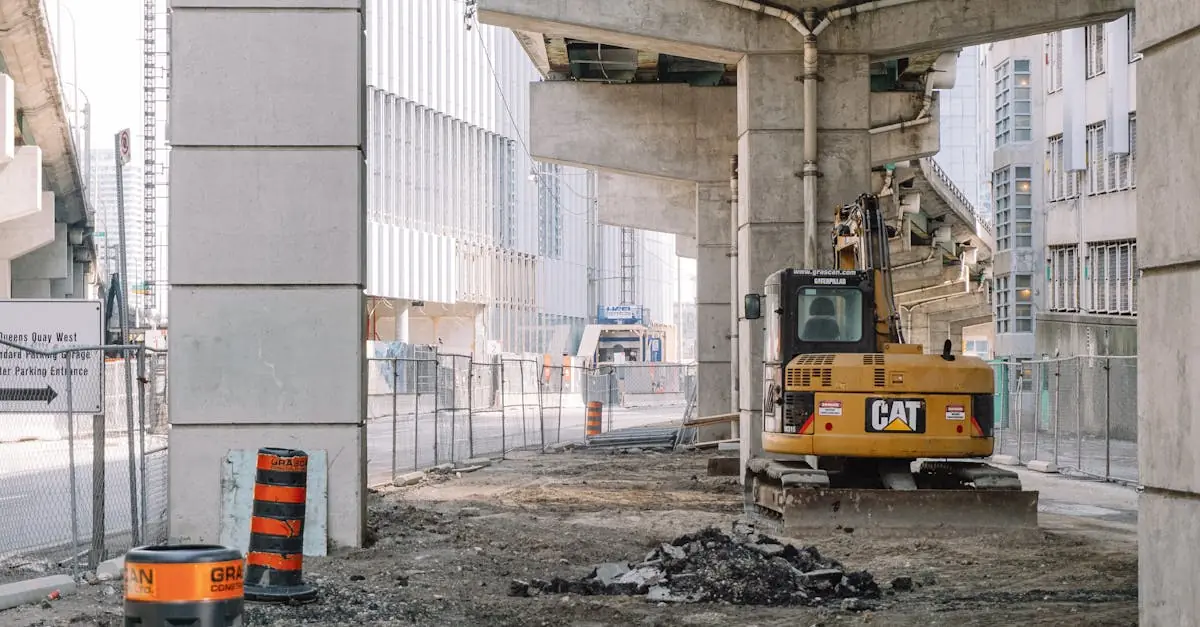Every driver knows the thrill of hitting the open road, but what happens when that road turns into a bumpy roller coaster? Road maintenance is the unsung hero of smooth travels, ensuring that potholes don’t turn into mini craters and that your tires don’t feel like they’re auditioning for a circus act. A well-crafted road maintenance checklist can save the day—or at least save your car from a dramatic encounter with a pothole.
Table of Contents
ToggleImportance Of A Road Maintenance Checklist
A road maintenance checklist serves as a vital tool for ensuring the safety and functionality of roadways. Such a checklist allows maintenance crews to systematically assess road conditions. Prioritizing tasks based on the checklist helps allocate resources efficiently. Identifying hazards early, like potholes or cracks, reduces risks of accidents and vehicle damage.
Immediate documentation of road conditions becomes essential with a well-structured checklist. Observing changes over time enables maintenance teams to track deterioration. Regular inspections based on this checklist facilitate timely repairs, minimizing disruption to traffic. Avoiding extensive repairs often relies on identifying small issues before they escalate.
Utilizing a checklist improves accountability among maintenance personnel. Each team member can focus on specific areas, leading to thorough inspections. Keeping a clear record of completed tasks aids in planning future maintenance schedules. Additionally, adherence to the checklist demonstrates compliance with regulatory standards and local guidelines.
Budget considerations also benefit from a road maintenance checklist. Accurate evaluations of repair needs help forecast maintenance costs. Prioritizing funding for urgent repairs stems from systematic assessments, ensuring that critical issues receive attention first.
Ultimately, implementing a road maintenance checklist enhances overall infrastructure quality. Such proactive measures lead to safer driving experiences and prolong the lifespan of roadways. Regularly updated checklists ensure that maintenance strategies remain effective over time.
Key Components Of A Road Maintenance Checklist
A comprehensive road maintenance checklist includes essential components to ensure roads remain safe and functional. These components guide crews in systematic evaluations and preventive actions.
Surface Inspection
Surface inspection focuses on identifying wear and damage on road surfaces. Cracks, potholes, and heaving must receive prompt attention to prevent further deterioration. Crews should assess the entire surface area for visible signs of distress. Regular inspections allow for quick repairs, which ultimately extends the roadway’s lifespan. Assessing surface conditions every three months promotes proactive maintenance.
Drainage Maintenance
Drainage maintenance plays a critical role in preventing water-related damage. Effective drainage systems minimize erosion and flooding, protecting road integrity. Crews should regularly inspect culverts, ditches, and drains to ensure they remain clear of debris. Addressing drainage issues immediately avoids costly repairs down the line. Monthly checks promote optimal drainage function and prolong roadway life.
Signage and Marking
Signage and marking ensure road safety and effective navigation. Regularly inspect all traffic signs for visibility and correctness. Markings, such as lane lines and crosswalks, should be clear and reflect current traffic regulations. Updating faded signs and lines enhances driver awareness and maintains compliance with safety standards. Schedule sign and marking reviews at least twice a year to stay current.
Best Practices For Implementing A Road Maintenance Checklist
Implementing a road maintenance checklist requires attention to several best practices to maximize its effectiveness.
Frequency of Inspections
Regular inspections play a crucial role in road maintenance. Establishing a consistent inspection schedule, such as monthly or quarterly, helps identify issues early. Inspecting more frequently in high-traffic areas ensures that minor problems don’t escalate. The timing of inspections should align with seasonal changes, as weather can significantly impact road conditions. This approach aids in anticipating and preventing damage caused by ice, rain, or extreme temperatures. By adhering to a planned inspection frequency, maintenance crews enhance the safety and longevity of roadways.
Documentation and Reporting
Thorough documentation is essential for effective road maintenance management. Each inspection should include detailed reports of findings, including date, location, and nature of identified issues. Accurate records enable teams to track the history of road conditions, highlighting patterns and recurring problems. Regular reporting fosters accountability among personnel and improves coordination within maintenance teams. Using a standardized reporting format allows for efficient communication and facilitates data analysis over time. Emphasizing clear documentation supports informed decision-making about priorities and resource allocation.
Common Challenges In Road Maintenance
Road maintenance faces several challenges that can hinder the effective upkeep of infrastructure. Weather conditions often pose significant issues. Heavy rainfall can lead to flooding, while freezing temperatures create ice, both of which damage road surfaces. Additionally, traffic congestion complicates maintenance efforts. High traffic volumes often prevent timely repairs and increase the risk of accidents during maintenance activities.
Funding shortages frequently emerge as another hurdle. Limited budgets restrict the ability to conduct comprehensive inspections and repairs. Consequently, maintenance crews may prioritize urgent repairs over necessary long-term solutions. Equipment failures can also disrupt maintenance schedules. Breakdowns can lead to delays, making it difficult to execute planned inspection and repair activities.
Safety concerns rank high among the challenges. Maintaining roadwork zones requires caution to protect both crews and drivers. Without proper signage and barriers, the risk of accidents increases during repair operations. Public awareness also plays a role. Educating motorists about ongoing maintenance projects helps reduce frustration and enhances safety on work sites.
Communication between agencies and crews proves vital for success. Effective coordination ensures that teams understand priorities and available resources. Moreover, unanticipated damage from utilities or projects can further complicate road maintenance efforts. Maintenance crews must quickly adapt and realign their strategies to address unforeseen issues.
Regular review of maintenance strategies is essential. This practice helps identify recurring challenges and develop more effective approaches. By keeping these challenges in mind, authorities can better prepare for the complexities of road maintenance, ensuring that safety and functionality remain priorities.
Conclusion
A road maintenance checklist is essential for maintaining safe and functional roadways. By systematically assessing conditions and prioritizing tasks, it helps prevent minor issues from escalating into major hazards. Regular inspections and thorough documentation ensure that maintenance teams can address problems promptly and efficiently.
Implementing best practices not only enhances the quality of infrastructure but also improves accountability among personnel. By staying proactive and adapting to challenges, agencies can ensure that roads remain safe for drivers while prolonging their lifespan. Ultimately, a well-maintained road network contributes to a smoother driving experience and promotes safety for all road users.








